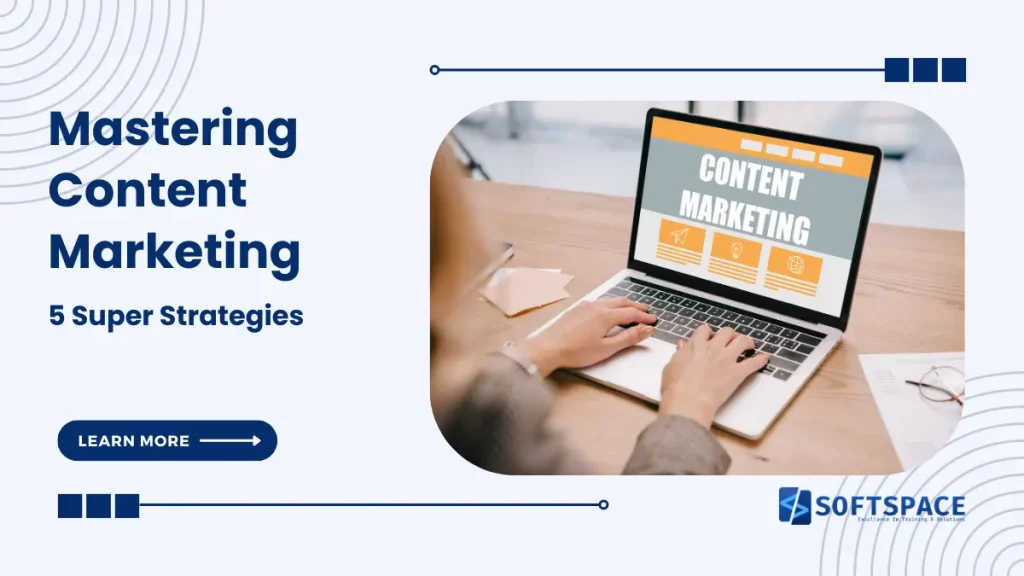Content marketing is one of the best ways of digital marketing. It is so powerful that 93% of B2B and 70% of B2C businesses use it as a core means of marketing. So, mastering content marketing is a top priority in today’s online existence.
Of course, this includes all kinds of content which means we are still talking in broad terms. However, content marketing is not really successful by employing just a single type of content. You have to use multiple types that suit your business to get the best results.
Anyway, the point of this article is to teach you some strong strategies for adding some pizzazz to your marketing. If you follow the strategies highlighted in this article, you will be able to increase the effectiveness of your marketing. This means more leads and more conversions. So, let’s check them out.
Table of Contents
Mastering Content Marketing For Maximum Impact
Given below are some of the key points to mastering content marketing that can help you improve the effectiveness of your marketing campaign.
Audience Research
First and foremost in any digital marketing skills related to content, you need to learn about your audience. Without knowing your audience, you won’t be able to create effective content that resonates with them. You should be mastering content marketing to bring in a quality audience.
So, what are the aspects of audience research? Well, some of the basic things you need to learn are:
- The demographic of your audience. Age and gender are some of the most common demographic elements that you need to know.
- The geographical region from which you get most of your traffic. Those are the people you need to satisfy with your content.
- The buying power of your audience.
- Their wants and needs concerning your products and services.
That’s a lot of data that needs to be collected, so how can you get it? Well, there are multiple ways of doing this without violating your customer’s privacy. But first and foremost is consent.
You should use clear methods of asking for consent, bereft of all dark patterns. This will not only purport a trustworthy image of you but also make you appear transparent. Customer love transparent companies that aren’t trying to pull the wool over their eyes.
Secondly, use “opt-in” data collection instead of “opt-out.” Ask your customers whether they want personalized results and content and give them the option to opt into data collection.
Also, ensure that you secure that data with the tightest security you can because nothing is worse than a company that gets data breached.
Determine Content Types
Now, once you know how to collect data, the next thing you need to ask yourself is “What kind of content do I create?” This is a must ask question in mastering content marketing.
Your customer data will give you insights into their likes, dislikes, preferred content type as well as what kind of tone they like best.
Does a majority of your audience like blog posts? Or do they like video content more? How about e-books? All of these questions will be answered by using the information you gathered about your consumers.
Regardless of the type of content you make, some universal tips will help you create the best content. They are given below.
- Aim for clarity. Do not use words that are hard to understand. Use clear and short sentences.
- Whether it’s a script for a video or content for a blog, it needs to be engaging. Use colourful language (without adding fluff) that makes your content more interesting to read.
- Add graphics and images to your content. Images are something that always adds to content quality—provided they are related to the content. Things like graphs, charts, and infographics also make your content easier to comprehend.
You can use tools for improving your content quality. For example, a free paraphrasing tool will help with increasing clarity and engagement. Similarly, graphic designing software will help with creating stylish images.
Since we are dealing with content, a paraphrasing tool and other content optimization tools will go a long way in improving content quality.
Determine Content Channels
Once you have determined content types and created some good pieces, it is time to check the channels you will use to dispense the content.
The most obvious choices are:
- Social media,
- Video-sharing websites,
- Emails,
- Blogs,
- And online journals
The content channel most useful for you will be dictated by two factors:
- The type of content
- The audience demographic.
The type of content is important because you won’t publish a blog post on a video-sharing website right? A blog post would go on a blog, a video would go on YouTube, and a newsletter would go in an email.
Similarly, the audience demographic will control content channels as well. You can expect young people to interact with your content on social media or video-sharing sites.
Older people may prefer emails and newsletters instead. Some may prefer reading blog posts or an e-book. Since you already have that information from your audience research, you will be able to determine content channels easily.
Search Engine Optimization
Search engine optimization is paramount for content marketing. Like it or not, most of your organic traffic comes from search engines. No matter how popular your social media page is, you cannot ignore the power of search engines.
According to businessedit.com, 93% of all website traffic comes from search engines. That is a huge amount of traffic. It would be folly to ignore the source of this traffic.
That’s why you should invest in SEO. Thankfully, content and SEO have a great relationship. You can optimize your content for SEO by doing the following:
- Keyword research. Find the terms that people use to reach your content and use them naturally.
- Make your content informative and scannable. Use headings, and other formatting tools to make it easy to find information.
The previously mentioned tip about using clear and well-written content also applies here. Similarly, there are also many tools you can use for keyword research such as Google Analytics.
Clever use of these tools will help you optimize your content for SEO.
Analysis of Strategies and KPIs
No strategy is complete without analysis and measuring key performance indicators. This is because no matter how much you prepare, you cannot predict human beings or the flow of search engine rankings.
Some of your strategies may bear fruit and others may straight up fail horribly. However, you won’t do that unless you stop and look back. After implementing any strategy, check your website traffic with the aforementioned Google Analytics.
Google Analytics provides information on how much traffic your web pages are getting and from which sources. This information will help you realize two things instantly:
- Which content channels are working, and which aren’t?
- Which content types are successful and which ones are a failure?
Further analysis by reading comments under your content may reveal what it was that worked or failed. Similarly, keep an eye on your KPIs (at least the ones that matter). Your conversions and amount of traffic are among the most important KPIs that you need to improve.
Double down on strategies that result in improvement of your KPIs while rectifying or removing strategies that have poor results.
Conclusion
So, there you have it, mastering content marketing with impactful strategies. In this article, we discussed 5 strategies that will help you make the most of your content. If you follow these strategies, you will get more traffic and more engagement as well as more conversions. However, be warned that not all strategies will give immediate results. It is common for most strategies to show results in 3-4 months. So, don’t worry if initially, it looks like nothing is working. Persevere and you will succeed.

13+ Yrs Experienced Career Counsellor & Skill Development Trainer | Educator | Digital & Content Strategist. Helping freshers and graduates make sound career choices through practical consultation. Guest faculty and Digital Marketing trainer working on building a skill development brand in Softspace Solutions. A passionate writer in core technical topics related to career growth.



